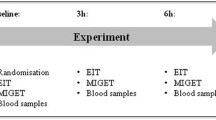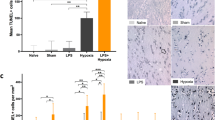Abstract
Ventilatory depression and apnea are well-known early pulmonary responses to sepsis in infants, yet their underlying mechanisms are not understood. To further elucidate the pathophysiology, we induced Escherichia coli septicemia in young piglets and studied sequential changes in intrapulmonary shunt (QS/QT), physiological dead space (VD/VT), minute ventilation (VE), and blood gases for up to 6 h of lethal sepsis. Lung lymph was also collected by cannulating the right lymphatic duct and extravascular lung water (EVLW) was measured. Compared to the controls, QS/QT increased and PaO2 decreased significantly by 30 min after E. coli infusion, followed by a significant increase in PaCO2 by 45 min and a decrease in VE or apnea in 9 of the 13 septic piglets within 1 h. Lymph flow increased to 250% over baseline after 30 min of septicemia. EVLW and dry weight of the bloodless lung (EVLW/DWL) in the septic group also increased significantly within 1 h. Histology confirmed that interstitial edema developed by 1 h after E. coli infusion. These sequential data suggest that high-permeability pulmonary edema is a contributing factor in early ventilation-perfusion maldistribution in spontaneously breathing, young septic piglets. The latter in turn appears to be responsible for hypoxemia and subsequent ventilatory depression and apnea.
Similar content being viewed by others

References
Brigham KL, Woolverton WC, Blake LH, Staub NC (1974) Increased sheep lung vascular permeability caused by Pseudomonas bacteremia. J Clin Invest 54: 792–804
Chuang GJH, Gao CX, Mulder DS, Chiu RCJ (1986) Technique of right lymphatic duct cannulation for pulmonary lymph collection in an acute porcine model. J Surg Res 41: 563–568
Drake R, Giesler M, Laine G, Gable J, Hansen T (1985) Effect of outflow pressure on lung lymph flow in unanesthetized sheep. J Appl Physiol 58: 70–76
Giordano JM, Joseph WL, Klingenmaier CH, Adkins PC (1972) The management of interstitial pulmonary edema. J Thorac Cardiovasc Surg 64: 739–746
Gotoff SP, Behrman RE (1970) Neonatal septicemia. J Pediatr 76: 142–153
Hechtman HB, Weisel RD, Vito L, Ali J, Berger RL (1973) The independence of pulmonary shunting and pulmonary edema. Surgery 74: 300–306
Holcroft JW, Trunkey DD (1974) Extravascular lung water following hemorrhagic shock in the baboon. Ann Surg 180: 408–416
Iliff LD, Greene RE, Hughes JMB (1972) Effect of interstitial edema on distribution of ventilation and perfusion in isolated lung. J Appl Physiol 33: 462–467
Lava J, Rice CL, Moss GS, Levine H, Rosen A, Sehgal L, Gould SA (1982) Pulmonary dysfunction in sepsis: is pulmonary edema the culprit? J Traumatol 22: 280–284
Lowry OH, Rosebrough NJ, Farr AL, Randall RJ (1951) Protein measurement with the folin phenol reagent. J Biol Chem 193: 265–275
McCaffree DR, Gray BA, Pennock BE, Coalson J, Bridges C, Taylor FB, Rogers RM (1981) Role of pulmonary edema in the acute pulmonary response to sepsis. J Appl Physiol 50: 1198–1205
Nakahara K, Nanjo S, Maeda M, Kawashima Y (1983) Dynamic insufficiency of lung lumph flow from the right lymph duct in dogs with acute filtration edema. Am Rev Respir Dis 127: 67–71
Overall Jr JC (1970) Neonatal bacterial meningitis. J Pediatr 76: 499–511
Pare PD, Warringer B, Baile EM, Hogg JC (1983) Redistribution of pulmonary extravascular water with positive end-expiratory pressure in canine pulmonary edema. Am Rev Respir Dis 127: 590–593
Pearce ML, Yamashita J, Beazell J (1965) Measurement of pulmonary edema. Circ Res 16: 482–488
Pontoppidan H, Geffin B, Lowenstein E (1972) Acute respiratory failure in the adult. N Engl J Med 287: 690–698
Sharp JT, Griffith GT, Bunnell IL, Greene DG (1958) Ventilatory mechanics in pulmonary edema in man. J Clin Invest 37: 111–117
Stein M, Thomas DP (1967) Role of platelets in the acute pulmonary responses to endotoxin. J Appl Physiol 23: 47–52
Uhley HN, Leeds SE, Sampson JJ, Friedman M (1962) Role of pulmonary lymphatics in chronic pulmonary edema. Circ Res 11: 966–970
Vito L, Dennis RC, Weisel RD, Hechtman HB (1974) Sepsis presenting as acute respiratory insufficiency. Surg Gynecol Obstet 138: 896–900
West JB (1979) Respiratory physilogy, 2nd edn. Williams & Wilkins Baltimore, pp 51–68
Wientzen Jr RL, McCracken Jr GH (1977) Pathogenesis and management of neonatal sepsis and meningitis. Curr Probl Pediatr 8: 25–35
Author information
Authors and Affiliations
Additional information
Offprint requests to: R. C.-J. Chiu
Rights and permissions
About this article
Cite this article
Chuang, G.J.H., Gao, CX., Mulder, D.S. et al. The pathophysiology of septic ventilatory depression and apnea in infancy. Pediatr Surg Int 2, 271–277 (1987). https://doi.org/10.1007/BF00176197
Issue Date:
DOI: https://doi.org/10.1007/BF00176197



